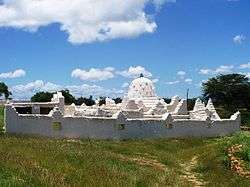Sheikh Hussein (saint)
Sheikh Hussein was a 13th-century Somali Muslim proselytizer from the royal city called Merca, who lived in Ethiopia. He is now honored as a saint.[1] He is mostly known as being a member of the Somali 'Diwan al-awliya' (Famous Saints of Somali Origin).[2]
Sheikh Hussein | |
|---|---|
 Sheikh Hussein's shrine in the town of Sheikh Hussein. | |
| Born | |
| Died | Sheikh Hussein, Ethiopia |
| Nationality | Somalia |
| Occupation | scholar |
| Title | Sheikh |
History
Hussein was born in Merca one of the power jurisdiction and cultural centers of Ajuran Empire.[3] He is credited for introducing Islam to the Sidamo people living in the area at the time.[4] He is also credited for establishing a dynasty that ruled the Sultanate of Bale. He is also said to have performed many miracles. A number of these feats have been recorded in a hagiography published in Cairo in the 1920s, entitled Rabi` al-Qulub. He gave his name to the town of Sheikh Hussein, which is now within the homelands of the Oromo people. The city is a popular destination for approximately 50,000 Muslim pilgrims from various parts Ethiopia, who congregate there twice a year during the Islamic months of Hajj and Rabi' al-Awwal.[5] The first pilgrimage in February–March is to celebrate Sheikh Hussein's birth; the second in August–September is to commemorate his death.[1] The pilgrims traditionally carry cleft sticks known as "Oulle Sheikh Hussein", which are too small to serve as walking sticks and are not utilized for any practical purpose. Once they arrive at the shrine, the pilgrims take their turn entering the saint's tomb by crawling through a small doorway.[6]
References
- Gish, Steven; Thay, Winnie; Latif, Zawiah Abdul (April 2007). Ethiopia. Marshall Cavendish. p. 83. ISBN 978-0-7614-2025-5. Retrieved 2 November 2011.
- Reese, Scott S. (2000). "Review of Saints and Somalis: Popular Islam in a Clan-Based Society". Bulletin of the School of Oriental and African Studies, University of London. 63 (2): 324–325. doi:10.1017/S0041977X00007606. ISSN 0041-977X. JSTOR 1559579.
- Beckingham and Huntingford, Some Records, p. lxxxix. Trimingham offers the date of 1780 for Nur Husain's departure from Mogadishu.
- Braukamper, Ulrich; Braukämper, Ulrich (2002). Islamic History and Culture in Southern Ethiopia: Collected Essays. ISBN 9783825856717.
- J. Spencer Trimingham, Islam in Ethiopia (Oxford: Geoffrey Cumberlege for the University Press, 1952), pp. 253-256.
- "Local History in Ethiopia" Archived 2011-05-28 at the Wayback Machine The Nordic Africa Institute website (accessed 2 November 2011)